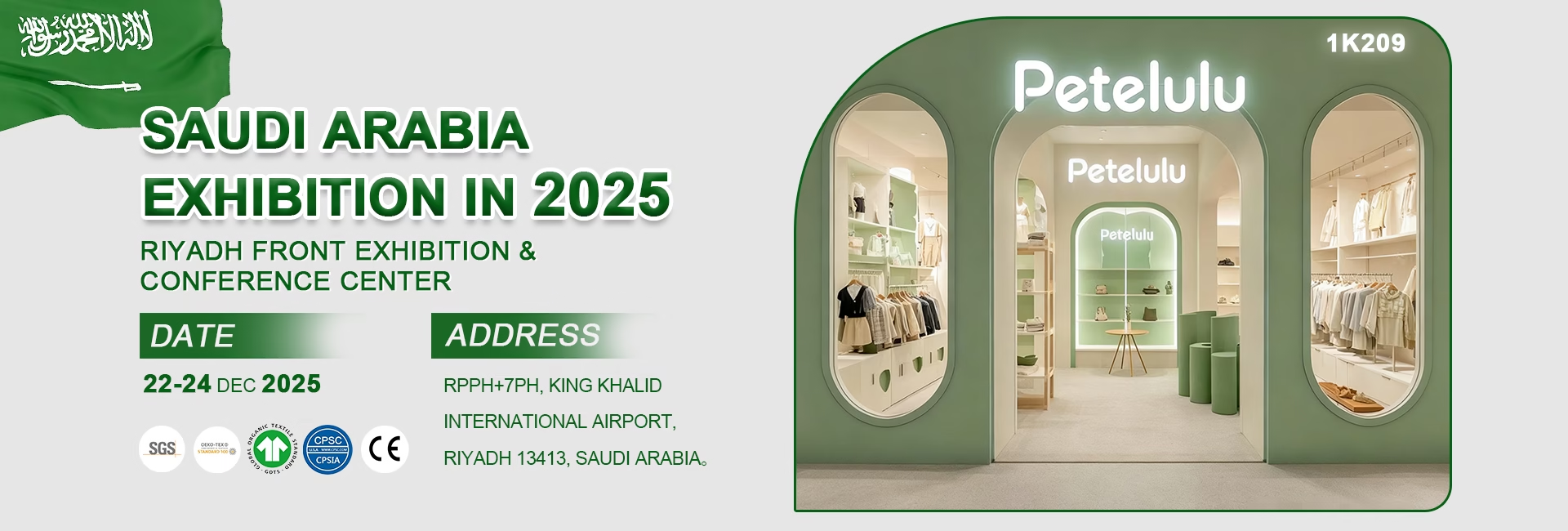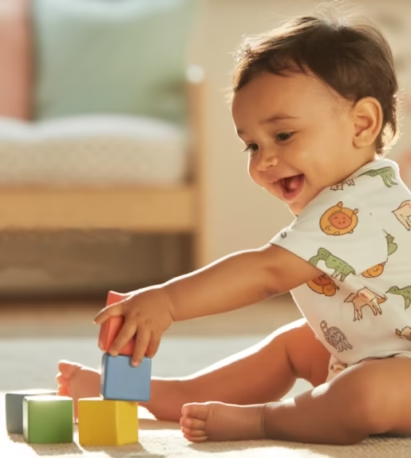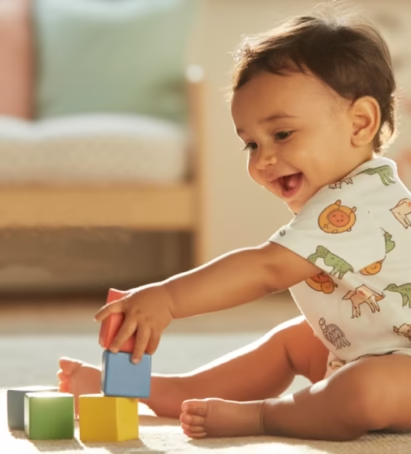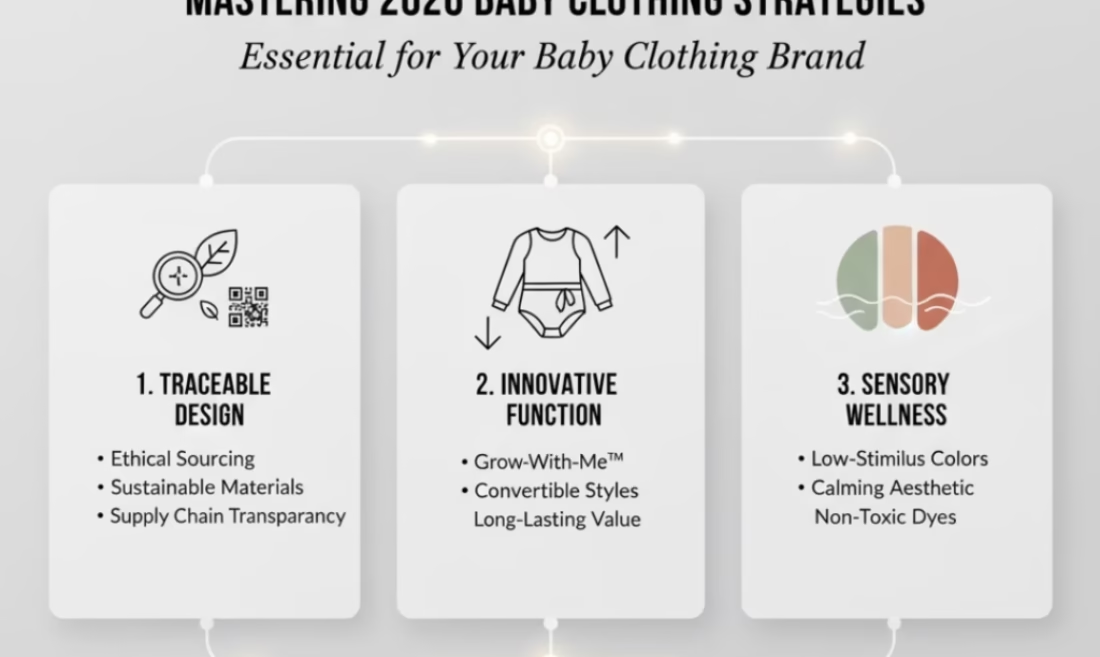3 Key Strategies for 2026 Baby Clothing Trends: Design to Manufacturing
Inhalt
- 1 3 Key Strategies for 2026 Baby Clothing Trends: Design to Manufacturing
- 1.1 Introduction: From Concept to Commercial Value
- 1.2 Macro Market Analysis: Realistic Challenges and Opportunities
- 1.3 Core Design Trends (Addressing the Pain Point): The 2026 Pragmatic Innovation Blueprint
- 1.4 Strategic Execution: Lean Manufacturing and Cost Control
- 1.5 Conclusion: Executable Design is the Future Growth Driver

Introduction: From Concept to Commercial Value
In 2026, the competition in the children’s wear market intensifies. The key to brand growth lies in addressing the core pain point: How to find novel, widely accepted design concepts without significantly increasing manufacturing costs, while simultaneously building a credible brand image. This report provides a pragmatic blueprint for Product Managers, Designers, and Brand Founders, guiding your Marke für Babykleidung to seize immediately achievable baby clothing trend concepts.
No idea how to make children’s clothes? This is the definitive, all-in-one guide the kids’ apparel industry doesn’t want you to have.
Macro Market Analysis: Realistic Challenges and Opportunities
We observe that by 2026, consumer demand for “sustainability” has shifted from an option to a basic requirement. However, they also demand reasonable pricing. Therefore, the focus of design innovation must be on supply chain optimization and material efficiency. The regionalization and efficiency improvements in global supply chains are expected to enable brands to offer high-quality, responsible products at more competitive prices


Mit 17 Jahren Erfahrung bietet petelulu eine umfassende Palette von
Fertigungsdienstleistungen vom Entwurf bis zur Lieferung.
Beginnen Sie bei Null, schaffen Sie Ihre eigene Marke.
17+
im Dienste der 10 wichtigsten amerikanischen Marken
15+
im Dienste der 10 wichtigsten australischen Marken
12+
im Dienste der 10 wichtigsten europäischen Marken
Kontaktieren Sie uns, um ein Angebot zu erhalten.👇
Core Design Trends (Addressing the Pain Point): The 2026 Pragmatic Innovation Blueprint
Successful, innovative design combines practicality, safety, and responsible production. Here are the three pragmatic pillars guiding the design strategy for 2026:
1. Supply Chain Transparency: Focus on Traceable Material Certification
The novel design concept lies in building trust. Brands must clearly communicate the story behind the product, relying not on complex digital technology, but on verifiable certification and batch tracing.
-
Design Innovation: “Traceability Badge Design.” Designers must focus on using fabrics certified by authoritative bodies like GOTS (Globaler Standard für ökologische Textilien) oder Öko-Tex Standard 100, and display their certification information (e.g., batch number, cotton origin) in a simple graphic or text format, high-visibility on the garment label or packaging.
-
Authoritative Insight: This pragmatic strategy significantly reduces the complexity of Herstellung von Babykleidung while enhancing the persuasiveness of Marketing für Babykleidung in the most direct and trustworthy manner.
2. Practical Functionality: Modular and Ultra-Durable Design
Design must solve parents’ daily usage pain points: quick changes and long-term durability. We encourage designers to create “parent-easing” apparel.
-
Functional Innovation: “Grow-with-Me Modular Design.“ Introduce hidden, adjustable designs for cuffs and hems, allowing a garment to adapt to a child’s growth for up to 12 months, rather than the traditional 6 months. Emphasize the use of high-abrasion resistance, easy-to-clean, and PFC-free waterproof fabrics, ensuring the clothing maintains its color and shape after multiple washes.
-
Target Group: This design directly addresses parents’ demand for “value and durability,” making the clothing functionally more competitive and establishing a new baby clothing trend.
3. Natural Colors and Sensory Safety: Low-Stimulus Design
Design must prioritize the safety and comfort of infants and toddlers, moving away from highly saturated, stimulating design elements.
-
Material and Color Innovation: Utilize natural plant dyes or low-reactive mineral dyes, focusing on a soft, earthy palette (e.g., sage green, oat white, baked apricot). In cutting, minimize inner seams and skin-irritating embellishments. All prints and embroidery must use water-based, eco-friendly, and soft materials.
-
Authority Assertion: We define this as “Low-Stimulus Design,” which provides a calmer, safer environment for infants by reducing visual and tactile stimulation. This significantly elevates the brand’s professional image.


Mit 17 Jahren Erfahrung bietet petelulu eine umfassende Palette von
Fertigungsdienstleistungen vom Entwurf bis zur Lieferung.
Beginnen Sie bei Null, schaffen Sie Ihre eigene Marke.
17+
im Dienste der 10 wichtigsten amerikanischen Marken
15+
im Dienste der 10 wichtigsten australischen Marken
12+
im Dienste der 10 wichtigsten europäischen Marken
Kontaktieren Sie uns, um ein Angebot zu erhalten.👇
Strategic Execution: Lean Manufacturing and Cost Control
Effective Herstellung von Babykleidung must serve pragmatic design. Brand founders should focus investments on quality control and standardized processes.
To help brands efficiently implement the 2026 design trends, we summarize key manufacturing and strategic execution points:
| Area | 2026 Recommended Actions (Active Voice) | Value/Effect |
|---|---|---|
| Supply Chain | We prioritize long-term contracts with fabric suppliers certified for specific environmental standards (e.g., bluesign®). | Ensures raw material quality and sustainability, reducing baby clothing manufacturing risk. |
| Design Efficiency | The design team focuses on simplifying cutting patterns, reducing waste and complex sewing processes. | Lowers production complexity and cost, increases capacity, supporting competitive pricing. |
| Marketing Strategy | The brand utilizes User-Generated Content (UGC) to highlight garment durability and grow-with-me features. | Enhances brand trust, optimizes baby clothing marketing, and attracts pragmatic consumers. |
Conclusion: Executable Design is the Future Growth Driver
The success of children’s wear brands in 2026 hinges on pragmatic and executable innovation. We advise brand founders to immediately shift the design focus from high-concept to high-efficiency, high-durability, and high-safety. Systematically implementing these design strategies effectively solves the consumer pain point of seeking “high value-for-money and high trust” products, solidifying your Marke für Babykleidung‘s market position.
Häufig gestellte Fragen (FAQ)
Q1: Will focusing on pragmatic design make our brand seem less “innovative”?
A: Quite the opposite. In 2026, true innovation is demonstrated by delivering superior practicality in a more responsible way. Traceable certification and grow-with-me designs are the most valuable baby clothing trend in consumers’ eyes.
Q2: How can we reduce Herstellung von Babykleidung costs through design trends?
A: By simplifying cuts and standardizing materials. Reduce the number of SKUs (using grow-with-me design) and focus on a few certified high-quality fabrics, which leads to economies of scale and lowers unit production costs.
Q3: How can small brands better implement “Supply Chain Transparency”?
A: Small brands should choose to partner with local or regional certified suppliers, making it easier to conduct site visits and obtain clear certification documents. In your Marketing für Babykleidung, focus on telling this “small, beautiful, and trustworthy” story.
Über den Autor
Xhiney, die Gründerin von Petelulu, verfügt über mehr als 20 Jahre Erfahrung in den Bereichen Design, Produktion und internationaler Handel von Kinderbekleidung. Ein Beitrag zu Kinderkleidung und Junior Magazinen hat Xhiney 17 Jahre lang mit hochwertigen Kinderbekleidungsmarken in Europa und den USA zusammengearbeitet und bietet Expertenwissen und Unterstützung.

